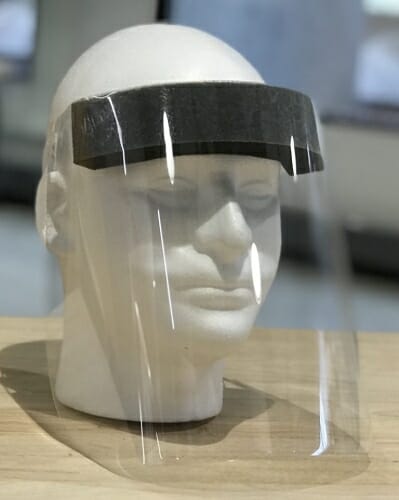UW–Madison engineers, local manufacturers race pandemic to protect healthcare workers
University of Wisconsin–Madison engineers are working with Madison-area manufacturers, the design consulting firm Delve, and campus colleagues on a product to help meet urgent and growing demand for medical face shields — key pieces of personal protective equipment (PPE) for healthcare workers treating coronavirus patients.
The team has created a first batch of face shields for UW Hospital, and plans to deliver samples to other local hospitals for user feedback. The group also has published its design as open source — see them on Delve’s website here — and it is already be replicated by others across the world.

The medical face shield created by UW–Madison engineers in collaboration with Madison companies can be manufactured quickly from readily-available materials. Photo courtesy of Grainger Engineering Design Innovation Lab
A phone call just a week ago from hospital staff to Lennon Rodgers, director of the Grainger Engineering Design Innovation Lab, the makerspace on the UW–Madison College of Engineering campus, led to a team including mechanical engineering professor Tim Osswald, local manufacturers Midwest Prototyping, Placon and Plastic Ingenuity, and Minnesota-based Summit Medical.
Since then, the group has built prototypes and launched a website where it’s encouraging healthcare facilities, manufacturers and donors to fill out an intake form to help assess need and build more connections while production capacity is rapidly expanded.
Given that Lennon’s wife, Jennifer Rodgers, is an anesthesiologist at UW Hospital, the goals are partly personal for him.
“This is just one piece of the equation,” Lennon says. “Hospitals need N95 masks and other critical equipment. Our aim is to provide the shields at cost — and maybe free if donors step forward. We’d like to get 100,000-plus packed up and shipped from Madison to hospitals in need ASAP.”
The group created a design based closely on the face shields currently in use at UW Hospital, consulting throughout with Robert Scheuer, director of materials management at UW Health, to ensure the product is medical-grade quality.
Mass production isn’t a problem. Placon estimates it can churn out 5,000 plastic shields an hour, and Rodgers says assembly time to create the finished product, which entails adding an adhesive-backed foam strip and a latex-free elastic headband, takes less than 30 seconds for each unit.
At this stage, though, the team is still trying to gauge demand across the country and even beyond, and connect with specific healthcare facilities that are interested in ordering shipments of face shields. And Rodgers notes that other facilities, such as prisons and nursing homes, could also benefit from having shields as the virus continues to spread.
“We could almost certainly ship millions of face shields over time if we can put together the final pieces of manufacturing and distribution. Equally critical is continually identifying the hospitals that need the face shields.” he says.
